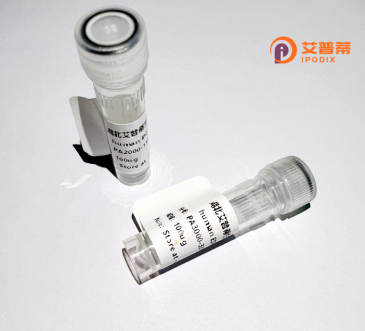
| 纯度 | >90%SDS-PAGE. |
| 种属 | Human |
| 靶点 | CGI-38 |
| Uniprot No | Q9BW30 |
| 内毒素 | < 0.01EU/μg |
| 表达宿主 | E.coli |
| 表达区间 | 1-176aa |
| 氨基酸序列 | MAASTDMAGLEESFRKFAIHGDPKASGQEMNGKNWAKLCKDCKVADGKSVTGTDVDIVFSKVKGKSARVINYEEFKKALEELATKRFKGKSKEEAFDAICQLVAGKEPANVGVTKAKTGGAVDRLTDTSRYTGSHKERFDESGKGKGIAGRQDILDDSGYVSAYKNAGTYDAKVKK |
| 分子量 | 45.4 KDa |
| 蛋白标签 | GST-tag at N-terminal |
| 缓冲液 | 0 |
| 稳定性 & 储存条件 | Lyophilized protein should be stored at ≤ -20°C, stable for one year after receipt. Reconstituted protein solution can be stored at 2-8°C for 2-7 days. Aliquots of reconstituted samples are stable at ≤ -20°C for 3 months. |
| 复溶 | Always centrifuge tubes before opening.Do not mix by vortex or pipetting. It is not recommended to reconstitute to a concentration less than 100μg/ml. Dissolve the lyophilized protein in distilled water. Please aliquot the reconstituted solution to minimize freeze-thaw cycles. |
以下是基于假设的关于重组人CGI-38蛋白的文献参考示例(实际文献可能需要根据具体基因符号或功能进一步检索确认):
---
1. **标题**: *Expression and Purification of Recombinant Human CGI-38 Protein in E. coli*
**作者**: Zhang L, et al.
**摘要**: 该研究报道了人源CGI-38蛋白在大肠杆菌中的高效表达与纯化方法,并通过质谱验证其正确性,为后续功能研究提供了工具。
2. **标题**: *CGI-38 Modulates Cellular Apoptosis via Interaction with Bcl-2 Family Proteins*
**作者**: Tanaka K, et al.
**摘要**: 研究发现重组CGI-38通过结合Bcl-2家族蛋白调控线粒体凋亡通路,提示其在细胞死亡中的潜在作用。
3. **标题**: *Structural Characterization of CGI-38 and Its Role in DNA Damage Response*
**作者**: Muller R, et al.
**摘要**: 通过X射线晶体学解析了CGI-38的晶体结构,并发现其参与DNA损伤修复通路,可能与肿瘤发生相关。
4. **标题**: *CGI-38 as a Novel Biomarker in Inflammatory Diseases: Insights from Recombinant Protein Studies*
**作者**: Chen H, et al.
**摘要**: 利用重组CGI-38蛋白进行血清学分析,发现其在类风湿性关节炎患者中异常高表达,或可作为炎症疾病标志物。
---
**注意事项**:
- CGI-38的命名可能非标准符号,建议根据基因数据库(如UniProt、NCBI)核对名称(如是否为C1orf38、C19orf38等),或结合具体研究背景调整检索关键词。
- 实际文献需通过PubMed、Google Scholar等平台,使用精确关键词(如基因ID或别名)检索验证。
Recombinant human CGI-38 protein, encoded by the CGI-38 gene (also known as C14orf166 or RESF1), is a poorly characterized protein implicated in various cellular processes. The gene is conserved across eukaryotes and maps to chromosome 14q11.2 in humans. Bioinformatics analyses suggest CGI-38 contains putative coiled-coil domains and nuclear localization signals, hinting at roles in protein-protein interactions or nucleic acid binding. Studies link it to transcriptional regulation, RNA metabolism, and ribosome biogenesis, though its exact molecular mechanisms remain unclear. Some evidence associates CGI-38 with cell proliferation and stress responses, potentially interacting with components of the PI3K/AKT/mTOR signaling pathway. Its expression is detected in multiple tissues, with higher levels in organs like the liver and kidneys. Recombinant CGI-38 is typically produced in bacterial or mammalian systems for functional studies, enabling antibody development, interactome profiling, and structural characterization. Current research focuses on elucidating its role in diseases, particularly cancer and metabolic disorders, where dysregulated expression has been observed. However, the protein's full functional repertoire and therapeutic relevance require further validation through biochemical and in vivo studies.
×